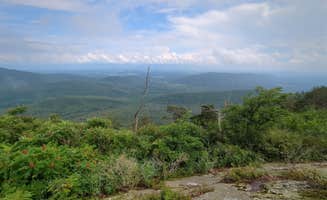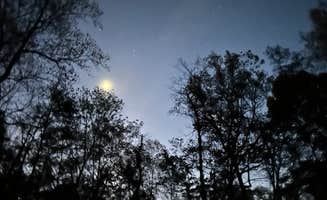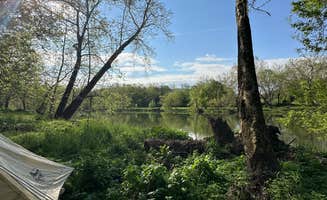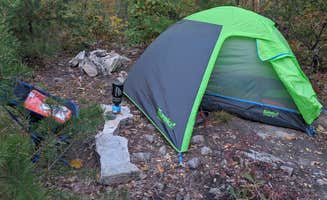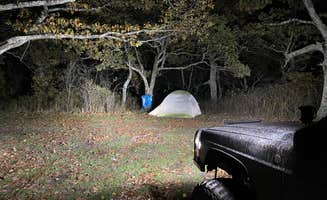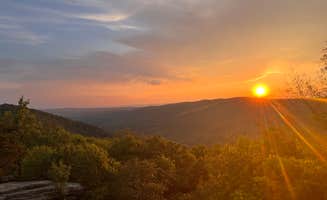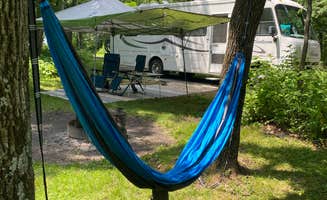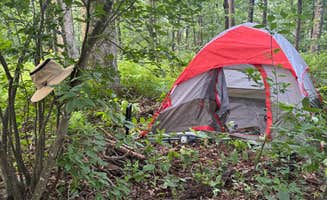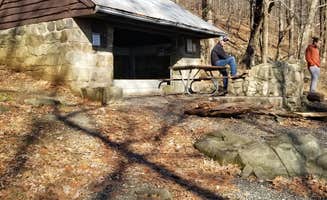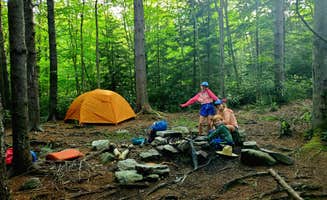Rustic camping near Orkney Springs, Virginia encompasses numerous forest roads and hiking trails across elevations ranging from 1,000 to 4,000 feet. Situated in the George Washington National Forest, the region experiences temperature variations up to 20 degrees between mountain tops and valleys, with nighttime temperatures often falling into the 40s even in summer months. Most primitive sites feature established fire rings and natural clearings but require campers to pack out all waste.
What to do
Fishing opportunities: Switzer Lake Dispersed Camping offers both lake and creek access for anglers. "The fishing is decent, and we have caught some trout there in the past. There is a boat ramp at the lake, but only electric motors and paddle boats are allowed," explains camper Emil D.
Creek exploration: Many sites feature small waterways perfect for wading and exploration. At South Fork Shenandoah River, "The site at the end of the road is beautiful. We stayed right at the end of the road, since we have a 30 foot RV, but there are sites you can walk to all the way down the river," reports Justine I., who also mentioned "we swam and fished" during their stay.
Off-road adventures: The forest service roads provide varying levels of challenge for vehicles. "I drove to Switzer Lake first and from there stayed on the trail all the way to Flag Pole. The drive took a few hours but was a ton of fun," notes Waseem H. from his experience driving through the network of forest roads.
What campers like
Seclusion from crowds: Many sites offer privacy from neighboring campers, particularly on weekdays. At Flagpole Knob, Sydney D. reports, "If you really wanna be alone this is the spot. Camped up there with just my dog and I doubt there was a single person for miles around."
Dark skies for stargazing: The remote locations provide excellent night sky viewing with minimal light pollution. Kevin C. notes that the Wolf Gap Recreation Area is "quiet and dark and a bit buggy" but provides excellent conditions for night sky observation.
Natural campsite features: The undeveloped nature of sites means unique natural features. "Most sites have a paved parking platform and then a second tier for the camp site. All sites are quite large and include picnic tables, fire rings and large tent platforms," reports Kevin C. about Wolf Gap Recreation Area.
What you should know
Road conditions: Access to many sites requires appropriate vehicles. Kylie B. warns about Switzer Lake: "The road was the worst and really not worth the drive in... you really have to drive way in to get to them." Meanwhile, Kevin C. notes Squirrel Hollow Road Camping sites are "located less than a mile from the paved highway... easily accessible by car or with a small teardrop trailer."
Weather preparation: Temperature swings between day and night can be dramatic, particularly at higher elevations. Sites near water tend to be cooler and more humid. Mike C. reported October temperatures at Switzer Lake averaging "61 [degrees] daily" but dropping to "30 [degrees] evening."
Wildlife encounters: Bears and other wildlife are common in the area. Emil D. cautions, "There are bears here, so lock up your food in the car. We have encountered a bear at or around the campsite 3 times" at Switzer Lake.
Tips for camping with families
Accessibility considerations: Some campsites require minimal hiking from parking areas. At Little Fort Campground, Sawyer B. noted the established nature made it family-friendly: "Site had a fire pit, table, parking spot, and tent platform... Nice trails/creek behind site."
Weekend timing: Family-friendly sites fill quickly on weekends, but midweek visits often find sites empty. Lindsay C. reports arriving "at 7:30pm on a Saturday in late August and thought I might be too late to get a spot but there were only two other groups there so I had my pick of most of the sites" at Little Fort Campground.
Noise levels: Some sites experience noise from nearby recreation. SJ W. mentioned Little Fort Campground is "next to an off-road vehicle trail and there was a lot of action coming down until about 7 PM." Similarly, Heather noted at South Fork Shenandoah River that "the real issue was the land directly across the river that had 20+ people playing loud music at almost all hours."
Tips from RVers
Turnaround space: Most forest roads have limited areas for larger vehicles to turn around. At South Fork Shenandoah River, camper Justine I. noted, "We stayed right at the end of the road, since we have a 30 foot RV, but there are sites you can walk to all the way down the river."
Dispersed sites with vehicle access: Crisman Hollow Road Camp provides creek access with vehicle parking. Roger V. describes it as a "Great off grid camping... spot near a creek," while Waseem H. notes "It a quiet area with many spots on right on the water."
Road clearance requirements: Most forest roads require vehicles with appropriate clearance. Kevin C. described Squirrel Hollow Road as suitable for "a small teardrop trailer" and noted the sites have evidence of "some traffic related to logging activity" that may affect road conditions.


